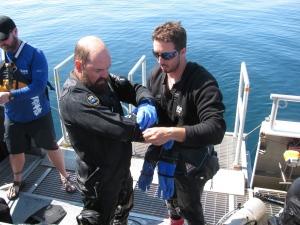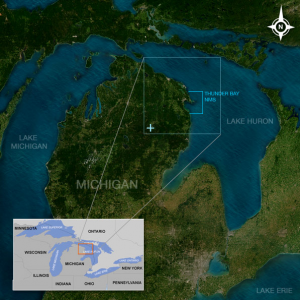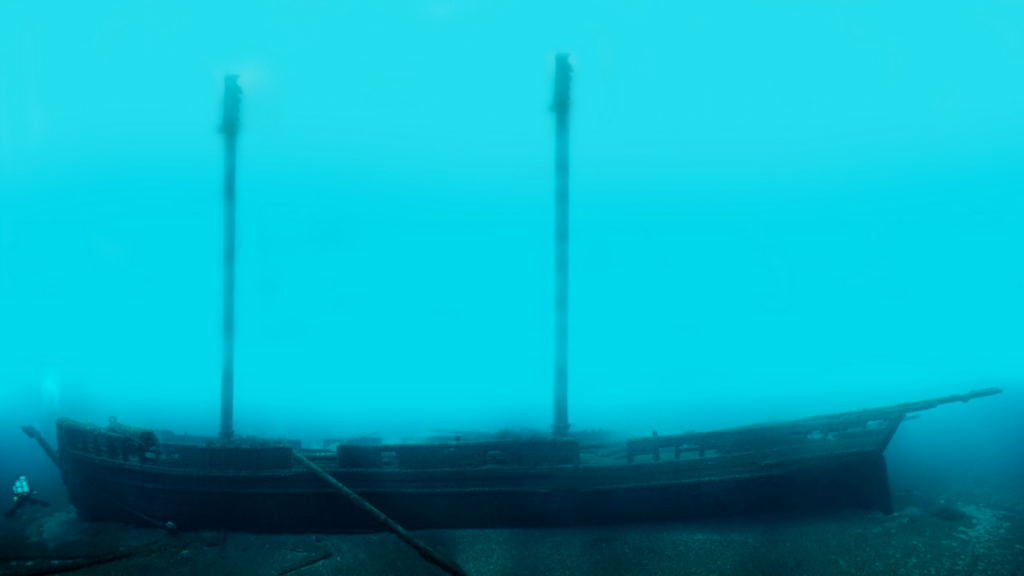 There are few things more dramatic and compelling than the ghostly hulks of wrecked ships. For those who do not live near the Great Lakes and experience their vastness on a daily basis, it is difficult to imagine shipwrecks on a grand scale occurring in a lake, but these are truly enormous bodies of water.
There are few things more dramatic and compelling than the ghostly hulks of wrecked ships. For those who do not live near the Great Lakes and experience their vastness on a daily basis, it is difficult to imagine shipwrecks on a grand scale occurring in a lake, but these are truly enormous bodies of water.
In the Thunder Bay National Marine Sanctuary on Lake Huron there are at least 25 registered wrecks of sailing vessels within the 4,300 square mile region. And that’s just one portion of one lake. Add to that another couple dozen sunken motor vehicles and eight barges, one poetically named Heart Failure, and there’s a world of underwater exploration – for those who can dive deep enough to see it.
 For the people who can’t get down to see these fascinating vessels, a team of marine archaeologists working in the area hope to be able to bring the wrecks up to them, in the form of digital models and 3D printed pieces.
For the people who can’t get down to see these fascinating vessels, a team of marine archaeologists working in the area hope to be able to bring the wrecks up to them, in the form of digital models and 3D printed pieces.
Support diver and graduate student at East Carolina University Ryan Bradley explained what 3D printing can do for the public’s understanding of the area known as Shipwreck Alley:
“People don’t have…a solid understanding of what the value of these sites are, but (that changes) when you can bring it to them in 3D. This technology allows average citizens to get a better understanding of maritime heritage…This is America’s history. It’s still there, it’s preserved, and it’s amazing.”
 It’s not only for the public that the divers are working to capture the wrecks. Even for experienced divers, there just isn’t enough time or money to explore or opportunities for examination needed to really study these remains. At depths of 130 feet, the diving is intense and, obviously, paper and pencil sketching is pretty much out of the question. These marine archaeologists have been taking photo and video of the sites, but now they are able to feed images into software that can produce a highly precise 3D image.
It’s not only for the public that the divers are working to capture the wrecks. Even for experienced divers, there just isn’t enough time or money to explore or opportunities for examination needed to really study these remains. At depths of 130 feet, the diving is intense and, obviously, paper and pencil sketching is pretty much out of the question. These marine archaeologists have been taking photo and video of the sites, but now they are able to feed images into software that can produce a highly precise 3D image.
Those 3D images and the prints that are made with them can be used to study the wrecks under more conducive circumstances and can even be used to track changes in the vessels over time. This technique for imaging is called photogrammetry and Joe Hoyt is the diver in charge of its execution in Thunder Bay. Recently, Hoyt and his team spent several days on a Great Lakes research vessel named Storm making the trip to eight deep water sites.
Hoyt described the benefits of photogrammetry with a marked tone of excitement:
“This is the first project we’ve really rolled it out on. The cool thing about this is it’s photo-realistic but it’s also perfect 3D, so you’re seeing all sides of it. And it’s perfectly scaled. It’s a really amazing, accurate tool for measuring and monitoring, and the biggest benefit is the time it takes to develop is very, very small.”

The Defiance, a 34-metre schooner that sank in 1854 after colliding with the John J. Audubon in Lake Huron, is one of the wrecks in the Thunder Bay National Marine Sanctuary that has been 3D-scanned by marine archeologists. (NOAA/Thunder Bay National Marine Sanctuary)
One wreck in particular that holds fascination is a ship called the Defiance that sank in 1854. Its demise came when it collided with the John J. Audubon and it settled about 200 feet below the surface only just off of the coast of Presque Isle in the northeastern Lower Peninsula. After drilling his team on the procedure, they descended and Hoyt needed only about a half an hour to collect all of the photos. After visiting other sites over the next days, he headed back to his office and worked up the 3D models.
This effort is part of a pilot program that could lead to the revision of the way in which standard shipwreck analysis is undertaken. It could also lead to the creation of ‘print your favorite wreck’ stations at places such as Thunder Bay and allow hundreds more people access to each ship than would ever otherwise be able to visit it. What are your thoughts on this creative application for 3D Printing? Discuss in the 3D Printed Shipwreck forum thread on 3DPB.com
Subscribe to Our Email Newsletter
Stay up-to-date on all the latest news from the 3D printing industry and receive information and offers from third party vendors.
You May Also Like
3D Printing Unpeeled: Orbex Investment, IndoMIM and HP, Ultrasonic Waves
INDO-MIM has bought three HP Metal Jet S100 printers, operating two in India and one in Texas. This is a win for HP because the company has deep experience in...
3D Printing News Briefs, April 3, 2024: Kickstarter FDM 3D Printer, Artificial Eyes, & More
In 3D Printing News Briefs today, we’re talking about an FDM 3D printer on Kickstarter, advancements in artificial eye creation, and 3D printed solenoids for electromagnets. Then we’ll move on...
Firestorm Gets $12.5M from Lockheed and Others to Automate Drone Production with 3D Printing
Firestorm Labs is advancing an initiative that has been a topic of discussion on our site for a while: automating drone swarm production. Drones are increasingly altering the landscape of...
3D Printing Leaders Team with Rivelin for Robotic Metals Post-processing
UK-based Rivelin Robotics is working on creating a manufacturing cell to automate the post-processing of metal 3D printed parts. If successful, this approach could reduce the costs of metal 3D...






























